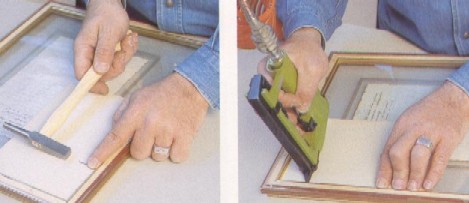Glass spacers are an almost hidden part of the frame, but are often indispensable.
Glass spacers are mainly used to distance the glass from the picture.
They can be wooden or plastic. In most cases they are made of plastic (usually PVC i.e. polyvinyl chloride).
The advantages of plastic over wood are these:
• Good rigidity coupled with a certain flexibility which makes them suitable also for certain shaped frames such as oval frames, round frames, fan trays.
• Cheaper price
• Constant length (always 2 meters)
• They are not attacked by woodworms.
• They are acid-free and therefore particularly suitable for conservation framing.
Glass spacers can be cut at 90° or 45° with both the saw and the guillotine. When they are inserted inside the frame, it is not clear whether the spacer has been cut at 90° or 45°.

If the frame is small (for example 18x24 cm) the spacers can simply be positioned inside the frame without being fixed. Their stiffness is enough to keep them in place.
If the dimensions of the frame are larger, they must be fixed inside the frame with glue or double-sided tape.
Flat spacers can also be used horizontally. In this case they take on the function of a thin passe-partout with the task of detaching the frame from the picture.

Spacers can also be used to hide the edge of frame paintings. In this case they must be applied to the frame with nails or with glue. Normal vinyl glue is fine. During the drying of the glue they should be kept pressed against the frame with rubber bands.

Another use of spacers is in double glazed frames. In this case they have the function of fixing the glass against the frame.
For this function they should preferably have a finish that does not differ from the finish of the frame. For example, if the frame is gold, the spacer should be gold.
Steel nails can be used to fix the spacers. If nails are too long break them by bending them with a hammer.
However, it would be preferable to use headless pins fired from a pneumatic gun.
While inserting the pegs, be careful not to break the glass. It would be good to protect the glass with a cardboard cutout. In this case the hammer or pneumatic gun can be placed on top of the cardboard.

The spacer could also be fixed with glue, but this would make it more difficult to reopen the frame if you had to replace the broken glass.
Souvenirs, objects that remind us of loved ones, trophies, jerseys worn by footballers, etc. are objects that are increasingly framed. For the framer this is a field that does not suffer from competition from department stores. In fact, there are hardly any frames ready for these applications on the market.
Frames of this kind must be made to measure especially to solve the problem of the volume of objects and how to fix them to the frame. Furthermore, the framer must have a certain skill to adopt the right solution.
The spacers in these cases are very important. They are used to give depth to the bottom panel to which the objects are fixed and to solve various problems of aesthetics and functionality.

For those who are not experts we must explain that conservation framing consists of a series of particular procedures to be used for the framing of pictures of high artistic, historical or emotional interest with the aim of protecting and preserving the pictire for a very long period of time.
Well, one of the fundamental rules of conservation framing is to distance the painting from the glass.
The condensation that is created inside the glass could, in fact, irreparably damage the framed painting, especially when it comes to paintings on paper, such as, for example, antique prints. Also, under certain circumstances, the print may adhere completely to the glass. It happens especially with certain vintage photos.
The glass can be spaced from the picture with two systems: with a passepartout or with a spacer.
In conservation framing the spacer cannot be made of wood since wood is not acid-free. So it can only be plastic (almost always PVC).
More information can be found in the series of videos about conservation framing made by Mal Reynolds.
Rinaldin can supply shaped spacers and straight spacers.
The shaped spacers are available in 3 heights: 10 mm - 15 mm - 18 mm

Rinaldin flat spacers are available in the colors: White, Black, Gold, Silver, Walnut, Natural wood, Gray.
For the colors white, black, walnut, natural wood, gray the paste of the material is the same color as the visible part.

The height of each color can be 5 - 10 - 15 - 20 - 25 - 30 mm.
The thickness is always 5 mm. The length is always 2 meters.

For frames with a rebate greater than 30 mm, two spacers can be coupled to reach the desired height.

All the colours of Rinaldin spacers are deliberately opaque. Inside the glass, a shiny spacer, in fact, would obtain strange light effects. Matt spacers are therefore also recommended for glossy frames.
In addition to plastic spacers, Rinaldin also has spacers made of bare wood (ayous).
They are available in sizes 10 - 15 - 20 - 25 - 30 - 35 - 40 mm. The thickness is 5 mm and the length of 3 meters. Bare spacers are very versatile as they can be colored as needed. They can also be lined with paper, cardstock or fabric.
